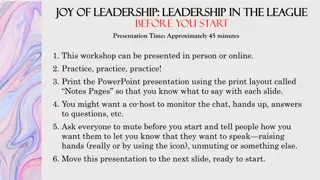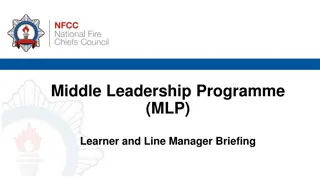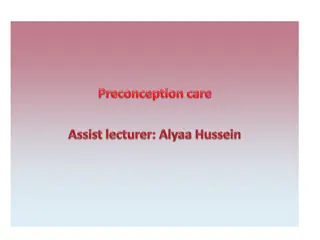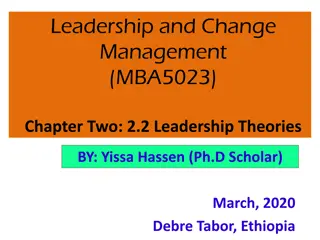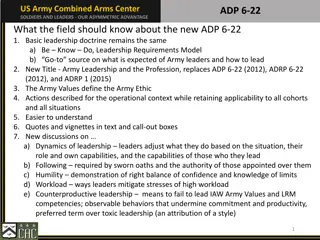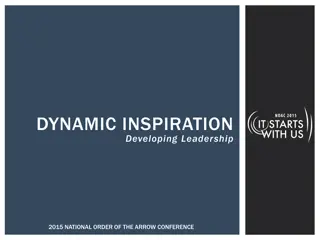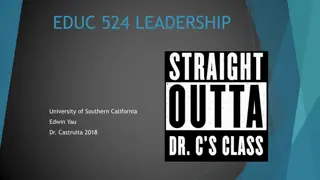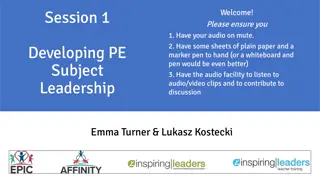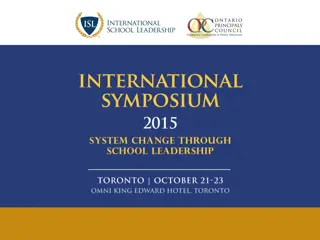Leadership in Health Care
Dive into the world of leadership in health care with this session focusing on defining leadership, exploring different theories and styles, understanding the role of a leader versus a manager, and delving into various types of power. Learn how leadership is about influencing, motivating, and inspiring others towards common goals, and discover the qualities that make a great leader. Uncover the essence of effective leadership through practical insights and thought-provoking discussions.
Download Presentation

Please find below an Image/Link to download the presentation.
The content on the website is provided AS IS for your information and personal use only. It may not be sold, licensed, or shared on other websites without obtaining consent from the author.If you encounter any issues during the download, it is possible that the publisher has removed the file from their server.
You are allowed to download the files provided on this website for personal or commercial use, subject to the condition that they are used lawfully. All files are the property of their respective owners.
The content on the website is provided AS IS for your information and personal use only. It may not be sold, licensed, or shared on other websites without obtaining consent from the author.
E N D
Presentation Transcript
Unit Four: Leading health care 1
Learning Objectives At the end of this session you will be able to: Define leadership Describe the leadership practices. Discuss different leadership theories, types & styles. Explain the differences between leader and manager. Describe on different types of power 2
Leadership I am more afraid of an army of 100 sheep led by a lion than an army of 100 lions led by a sheep Talleyrand 4
What is Leadership? What is Leadership? Multidimensional concept that can be defined in different ways, The ability to influence a group toward the achievement of goals. leadership is Enabling Groups to Make Progress in Complex Conditions. Management sciences for health (2006) Leadership is not domination, but the art of persuading people to work toward a common goal. Goleman and Daniel,1995. 5
Leadership Leadership is always exercised in relationship with others. The true test of effective leadership is the visible progress towards the realization of vision, inspire others to follow. Leadership involves unequal distribution of power between the leader and group members. 6
Leadership The leader must win the willingness of the workers to accept directions. Leaders are agents of change agents of change, persons whose acts affect other people more than other people s acts affect them. Leadership is an activity that takes place at all levels, not a position of authority 7
Leadership is about: Leadership is about: Influencing Motivating Inspiring Taking people to greater heights Working with participants on the how and helping them figure out the what and why Encouraging them to push themselves to achieve the highest possible performance Action Enabling, not telling 8
Who is a leader? A leader is an individual in a team influencing group activities towards goal formulation and achievement. In other words, a leader is someone who has a vision, and the ability to make it a reality. 9
Who is a leader? To achieve objectives Influence followers behavior 10
Dimensions Dimensions of of leadership leadership Leadership involves not just doing but being Leadership is exercised with others. Leadership is responsibility, not rank, title, privilege, or money. Leadership and management are both necessary. Leadership is about enabling people to face challenges. 11
Leading Practices Four Leadership Practices Four Leadership Practices 1. 1. Scanning Scanning 2. 2. Focusing Focusing 3. 3. Aligning/ Aligning/Mobilizing Mobilizing 4. 4. Inspiring Inspiring 13
Leadership Practice: Scanning Leadership Practice: Scanning Leaders encourage their teams to scan their internal & external environments, organizations, teams, and themselves. Identify client & stakeholder need & priorities Recognize trends, opportunities, & risks that affect organizations. Identify staff capacities & constraints. Know yourself, your staff, & your organization values, strengths, & weakness. 14
Leadership Practice: Focusing Leadership Practice: Focusing Using information from scanning, focus on a response. Leaders focus their limited time, energy, and resources on the people and things that are most important. Articulate the organization s mission & strategy Identify critical challenges Link goals with the overall organizational strategy Determine key priorities for action 15
Leadership Practice: Aligning/Mobilizing Leadership Practice: Aligning/Mobilizing A leader aligns and mobilizes others to achieve objectives. This means seeking out other groups or people whose objectives are in line with yours and getting them to work alongside you. You should align and mobilize stakeholders and staff time and energies as well as the material and financial resources to support organizational goals and priorities. Facilitate teamwork. 16
Leadership Practice: Inspiring Leadership Practice: Inspiring Helps staff to face challenges creatively. They are the people whose example moves us to follow in their footsteps. Inspiring involves demonstrating: Values through actions as role model & supporting staff Walking the talk - matching deeds with words. Trust & confidence in staff, acknowledging their contribution Be a model of creativity, innovation ,learning& supporting staff. 17
Manager Vs Leader Manager Vs Leader Sometimes used interchangeably. A person emerges as a leader. A manager is put in to his position by appointment. If a manager cannot influence others he is not a good leader; though he is a manager. There are good leaders who are not managers. 18
Managers Managers Leaders Leaders Cope with system complexity Seeks change Plan and budget Set direction and shared values Control and solve problem Motivate people Administers A copy Maintains Focuses on systems &structure Relies on control Short- range view Asks how and when Eye on the bottom line Imitates Does things right Innovates An original Develops Focuses on people Inspires trust Long-range perspective Asks what and why Eye on the horizon Originates Does the right thing 19
Approaches to leadership 1. The trait approach(Theory): The trait approach(Theory): It was assumed that some people are set apart from others by virtue of their possession of some quality or qualities of greatness and that it is these people who become leaders. This approach to leadership suggests that it is personal characteristics, or traits, that differentiate leaders from those they lead. Leaders are born but not made 20
The trait approach The trait approach These leadership traits include personality personality characteristics confidence), characteristics (adaptability, dominance, self- physical physical characteristics characteristics (above-average height, medium weight, attractive appearance), and ability ability (intelligence, task expertise, sensitivity in dealing with others). 21
2. The behavioral approach(Theory): The behavioral approach(Theory): Assumptions Assumptions: : - Leaders can be made, rather than are born. - Successful leadership is based in definable, learnable behavior. Description Description: : Behavioral theories of leadership do not seek inborn traits or capabilities. Rather, they look at what leaders actually do. Studied behavioral characteristics of leaders; What they do and how they interact with the subordinates; 22
3. The contingency approach: The contingency approach: Leadership could vary with the situation or circumstances. Focuses on task requirements. No single trait has been shown to be common to all effective leaders and no single style has been found to be effective in improving staff performance in all situations. The management technique that best contributes to the attainment of organizational goals might vary in different types of situations or circumstances. 23
Types of leaders Types of leaders 1. 1. Transactional leaders Transactional leaders Identify the expectations of their followers Act managerially by establishing a close link between effort and reward. They evaluate, correct and train staff whenever staff performance needs to be improved, and they reward appropriately when the required outcomes are achieved. Power is given to the leader to evaluate and reward the followers. 24
2. Transformational leaders 2. Transformational leaders Transformational leaders, as defined by Bass (1985) support their staff and encourage them to do more than they originally expected to do . Transformational leaders motivate staff to do better. Transformational leaders provide encouragement and support to followers. show trust and respect for them as individuals. They build self-confidence and heighten personal development. 25
Types of Leaders Types of Leaders 3. Charismatic leaders Max Weber, a sociologist, defined charisma (from the Greek for gift ) more than a century ago as a certain quality of an individual personality, by virtue of which he or she is set apart from ordinary people. Charismatic leaders rely on their personality, their inspirational qualities and their aura/ characteristic. Key Characteristics of a Charismatic Leader Vision and articulation Willing to take on high personal risk Sensitive to follower needs 26
Types of Leaders 4 4. . Situational leaders Situational leaders Is one who can adopt different leadership styles depending on the situation. Effective leaders are versatile/Adapt in being able to move between the styles according to the situation situation, so there is no one right style. 27
Leadership styles Leadership styles It is the typical pattern of behavior that a leader uses to influence their employees to achieve organizational goals. 1. Autocratic Autocratic Leaders: Leaders: Make decisions and announce them. There is also a clear division between the leader and the followers. Do just what I say or Don t touch the hot iron . Subordinates carry out orders Believe that money is the only reward that will motivate staffs. 28
Styles of Leadership 2. Democratic 2. Democratic /participative /participative Leaders Leaders: Democratic leaders, also known as participative leaders, encourage group members to participate. Democratic leaders keep staff informed about everything that affects their work and share decision-making and problem-solving responsibilities. Group members feel engaged in the process and thus are more motivated and creative. Permit subordinates to make decisions Ideas are bilaterally proposed What do you think? Let s do together 29
Democratic Democratic /participative /participative Leaders Leaders This style is most successful when used with highly skilled or experienced staff or when implementing operational changes or resolving individual or group problems. This is a popular style because when it is done well it creates a harmonious, productive and developing work force. 30
Styles Leadership. 3. Laissez 3. Laissez faire faire Leaders: Leaders: Laissez-faire leadership is a style where the leader provides little or no direction and gives staff as much freedom as possible. All authority or power is given to the staff and they determine goals, make decisions, and resolve problems on their own. The laissez-faire leader promotes a strong sense of competence and expertise in team members and allows others to rise to their performance potential. This style can lack accountability for team failures. Type I Leaders have little or no confidence in their ability Do as you like Have no concern for both staffs and the work output. 31
Laissez Laissez faire faire Leaders Leaders . Type II: Leaders are extremely confident about their staffs. Subordinates may be high in their academic position. Every staff knows the objectives of his / her organization. Able to plan and implement independently. 32
Leadership use of power and authority Leadership use of power and authority Leaders influence people to do things through the use of power and authority. 34
Leadership use of power and authority Leadership use of power and authority Authority is the formal right to get people to do things or the formal right to control resources. Factors within a person, such as talent or charm, help them achieve power. Power Power is the ability to influence decisions and control resources. Powerful people have the potential to exercise influence, and they exercise it frequently. Only the organization can confer authority. 35
Five types of power 1. Legitimate power 1. Legitimate power It is a result of the position a person holds in the organization hierarchy. It is the easiest type of influence for most staff to accept. For example For example, virtually all employees accept the manager s authority to conduct a performance evaluation. 37
2. Reward power Emanates/issue from the leaders ability to reward desirable behavior. It stems partly from the legitimate power. Reward includes pay increase, promotions, work schedule, recognitions of accomplishment, etc 38
3. Coercive power is the opposite of reward power based on the leader s ability to punish or prevent them from obtaining desired rewards. Organizational punishments include assignment to undesirable working hours, demotion, and firing. Effective leaders generally avoid heavy reliance on coercive power. 39
4. Expert power It derives from a leader s job-related knowledge as perceived by group members. This type of power stems from having specialized skills, knowledge, or talent. Expert power can be exercised even when a person does not occupy a formal leadership position. 40
5. Referent power It refers to control based on loyalty to the leader and the group members desire to please that person. Having referent power contributes to being perceived as charismatic, but expert power also enhances charisma. Part of the loyalty to the leader is based on identification with the leader s personal characteristics. 41
Thank you!! Thank you!! 42



